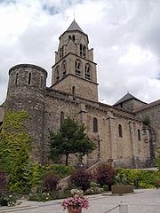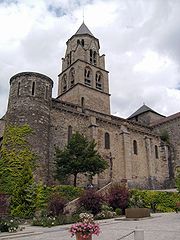
Uzerche
Encyclopedia

Communes of France
The commune is the lowest level of administrative division in the French Republic. French communes are roughly equivalent to incorporated municipalities or villages in the United States or Gemeinden in Germany...
in the Corrèze
Corrèze
Corrèze is a department in south central France, named after the Corrèze River.The inhabitants of the department are called Corréziens or Corréziennes according to gender.-History:...
department in the Limousin
Limousin (région)
Limousin is one of the 27 regions of France. It is composed of three départements: Corrèze, Creuse and the Haute-Vienne.Situated largely in the Massif Central, as of January 1st 2008, the Limousin comprised 740,743 inhabitants on nearly 17 000 km2, making it the second least populated region of...
region
Régions of France
France is divided into 27 administrative regions , 22 of which are in Metropolitan France, and five of which are overseas. Corsica is a territorial collectivity , but is considered a region in mainstream usage, and is even shown as such on the INSEE website...
of central France
France
The French Republic , The French Republic , The French Republic , (commonly known as France , is a unitary semi-presidential republic in Western Europe with several overseas territories and islands located on other continents and in the Indian, Pacific, and Atlantic oceans. Metropolitan France...
.
In 1787, the English writer Arthur Young described the city as "The Pearl of the Limousin," nicknamed because of its picturesque setting, and a name by which it is still widely known today. Built atop a rocky outcrop, surrounded by a meander of the river Vézère which it dominates, Uzerche possesses a rich cultural heritage. First as a centre of influence and an important crossroads fortress under Pepin the Short, the city was also the seat of a powerful abbey and later a Seneschal. This legacy means that Uzerche features castles, hotels and other buildings marked by turrets [1] that were built by the uzerchoise nobility and that can still be seen today, thereby, adding weight to the saying, "He who has an Uzerche house has a castle in the Limousin [2].
Location
Uzerche is a hill town, built on a deeply-incised meander of the VézèreVézère
The Vézère is a 211 km long river in south-western France, right tributary of the Dordogne River. Its source is in the north-western Massif Central...
River. As such, it is a natural citadel. Uzerche is located a few kilometres beyond the western edge of the Plateau de Millevaches
Plateau de Millevaches
right|thumb|220px|Plateau de MillevachesThe Plateau de Millevaches is an upland area in the Limousin région of France...
. Situated directly on one of France's main north-south routes historically, it is now by-passed to the west by the A20 autoroute
A20 autoroute
The A20 autoroute or L'Occitane is a highway through central France.-Regions Crossed:The road travels through the areas of Occitania, Limousin and Midi-Pyrénées. It starts at Vierzon in Cher and finishes in the south at Montauban in Tarn-et-Garonne...
.
History
Uzerche's history as a fortified town began in the late Roman period. According to legend, Uzerche was evangelised by Saint MartialSaint Martial
Saint Martial was the first bishop of Limoges in today's France, according to a lost vita of Saturnin, first bishop of Toulouse, which Gregory of Tours quotes in his History of the Franks.-Life:...
, the first bishop of Limoges. It remained an important citadel and ecclesiastical centre throughout the Merovingian and Carolingian
Carolingian
The Carolingian dynasty was a Frankish noble family with origins in the Arnulfing and Pippinid clans of the 7th century AD. The name "Carolingian", Medieval Latin karolingi, an altered form of an unattested Old High German *karling, kerling The Carolingian dynasty (known variously as the...
periods.
A Benedictine abbey was founded in the 9th century. In the 11th century, a major Romanesque
Romanesque architecture
Romanesque architecture is an architectural style of Medieval Europe characterised by semi-circular arches. There is no consensus for the beginning date of the Romanesque architecture, with proposals ranging from the 6th to the 10th century. It developed in the 12th century into the Gothic style,...
abbey church was constructed at the summit of the town. It was consecrated in 1097. With some Gothic
Gothic architecture
Gothic architecture is a style of architecture that flourished during the high and late medieval period. It evolved from Romanesque architecture and was succeeded by Renaissance architecture....
additions, this constitutes the abbatiale Saint-Pierre or Abbey Church of St Peter, which commands all views of the town to this day.
As a major route junction and market town, Uzerche continued to grow throughout the medieval period. It became the seat of a royal seneschal
Seneschal
A seneschal was an officer in the houses of important nobles in the Middle Ages. In the French administrative system of the Middle Ages, the sénéchal was also a royal officer in charge of justice and control of the administration in southern provinces, equivalent to the northern French bailli...
and the recognised capital of the lower Limousin.
The mid-18th century saw the construction across the river of a notable bridge, the Pont Turgot
Anne Robert Jacques Turgot, Baron de Laune
Anne-Robert-Jacques Turgot, Baron de Laune , often referred to as Turgot, was a French economist and statesman. Turgot was a student of Francois Quesnay and as such belonged to the Physiocratic school of economic thought...
, the main approach to the town today. In 1855, a major tunnel improved access along the main north-south route, later the RN20
Route nationale 20
The Route nationale 20 is a trunk road between Paris and the frontier with Spain heading south through the heart of France and passing through the Cathedral City of Orléans and Toulouse. The road forks at Col de Puymorens with one branch being the Route nationale 22 which leads to Andorra...
. The arrival of the railway in the late 19th century resulted in the construction of large viaducts and tunnels, some of which have since become redundant and form footpaths from which to view the town.
Another major product of the period is the town's old lycée or grammar school, which was built deliberately alongside the abbey church, in a commanding position above the river, symbolically challenging the old clerical order in the town.
The town today retains a large number of medieval and early modern buildings, all dominated by the ancient abbey, with the school and the mairie, arranged around a steeply sloping square, now named the Place de la Libération. It has seen a rapid growth in tourism in recent years.

